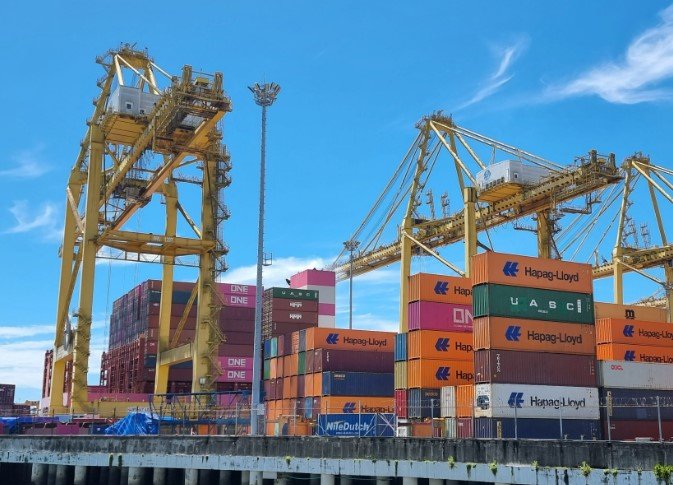A sharp rise in goods exports—led by building materials and metals—has pulled Egypt’s trade deficit down to its lowest point since 2019.
Egypt is breathing easier—at least on the economic front. The country’s non-oil trade deficit fell to $14.3 billion in the first half of 2025, a significant 18% drop compared to the same period last year. It’s the smallest trade gap Egypt has recorded in six years, Bloomberg reported late Sunday.
The improvement didn’t happen by accident. A surge in exports, particularly in building materials and metals, gave the country a much-needed lift. Exports climbed 22% year-on-year, reaching $24.5 billion between January and June. Imports rose too—but only slightly, up just 3% to $38.8 billion.
That’s a trade win Cairo hasn’t seen in a long time.
Building Materials, Metals Lead the Export Charge
There’s no mystery about who’s driving Egypt’s export turnaround: construction and heavy industry. The building materials and metals sector alone accounted for 30% of the country’s total goods exports, roughly $7.5 billion.
That’s not just pipes and steel sheets—it’s also cement, aluminum products, copper wires, and steel rebar. Most of it’s heading to Gulf countries, Africa, and even parts of Europe hungry for construction inputs.
One sentence here. Because the point hits hard.
Egypt is finally selling more of what it used to import.
And it’s not just construction. Other growing sectors include:
-
Chemical products, especially fertilizers and polymers
-
Agricultural exports such as citrus, potatoes, and onions
-
Electrical appliances and components, particularly those assembled domestically
The trend is a sign that Egyptian industry, long hindered by currency instability and import reliance, is starting to turn a corner.

Imports Still High, But Growth Slows Down
Let’s be clear: Egypt still imports more than it exports. But the pace of import growth is slowing—and that’s what matters right now.
In H1 2025, imports totaled $38.8 billion, up just 3% from the same period last year. For a country that’s struggled to contain foreign currency outflows, that’s a win—even if it’s a modest one.
Much of the import value came from:
-
Machinery and production equipment
-
Pharmaceuticals and medical supplies
-
Wheat, corn, and soybeans
-
Energy-related imports, including petroleum products
But there was a noticeable decline in luxury and non-essential goods. Government curbs on non-productive imports, combined with tighter dollar availability, have kept that in check.
One-sentence paragraph again. Because it needs no elaboration.
When you’re fighting inflation, every container counts.
A Trade Chart Worth Watching
Here’s how Egypt’s trade numbers stacked up in the first half of the year:
| Category | H1 2024 | H1 2025 | % Change |
|---|---|---|---|
| Exports | $20.1B | $24.5B | +22% |
| Imports | $37.7B | $38.8B | +3% |
| Trade Deficit | $17.4B | $14.3B | -18% |
The sharp drop in the trade deficit is the headline. But look closer, and the real story is a slow but steady rebalancing of Egypt’s external accounts.
Policy Moves Behind the Numbers
This didn’t happen in a vacuum.
The Egyptian government has quietly introduced a set of policies to stimulate exports and rein in unnecessary imports. These include:
-
Export subsidy programs for manufacturers
-
Streamlined customs procedures to reduce clearance times
-
Tightened rules on import documentation and foreign exchange usage
-
Incentives for local production of goods previously imported
The Central Bank of Egypt has also played a role, managing the pound in a way that keeps exports competitively priced while trying not to stoke inflation.
Still, not everyone’s thrilled. Some importers argue that new rules have slowed down their business. But policymakers say the short-term pain is worth it.
After all, Egypt’s foreign reserves were under pressure for years. Anything that eases that burden, even slightly, is welcomed.
Exporters Gain Confidence, But Risks Remain
Manufacturers are cautiously optimistic.
Many exporters say the past six months were among their best since 2018. A few textile producers even reported full order books stretching into October. That’s rare.
But challenges remain.
-
Shipping costs are volatile, especially through the Suez Canal.
-
Raw material prices are still unpredictable.
-
And Europe’s weak construction sector could hit demand for Egyptian metals later this year.
Also worth noting: Egypt’s non-oil exports are still dwarfed by its import bill. It will take several more quarters of growth before a true balance is in sight.
Yet the sentiment on the ground has clearly shifted.
One exporter told Bloomberg, “We used to beg for dollars to import raw materials. Now we’re shipping finished products to Europe and getting paid in euros. It’s a different world.”
What This Means for Egypt’s Economy
Egypt is still grappling with inflation, a weaker pound, and high debt. But a shrinking trade deficit gives it breathing room.
The government hopes this momentum will attract more investment in industrial zones, ports, and logistics. There’s already talk of new export hubs in the Nile Delta and Upper Egypt.
Finance Minister Mohamed Maait recently said Egypt was targeting $60 billion in total exports by the end of 2025—ambitious, yes, but not impossible.
If the first half of 2025 is any indication, the country might just be on its way.
